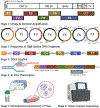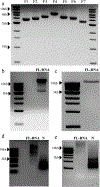Engineering SARS-CoV-2 using a reverse genetic system
- PMID: 33514944
- PMCID: PMC8168523
- DOI: 10.1038/s41596-021-00491-8
Engineering SARS-CoV-2 using a reverse genetic system
Abstract
Reverse genetic systems are a critical tool for studying viruses and identifying countermeasures. In response to the ongoing COVID-19 pandemic, we recently developed an infectious complementary DNA (cDNA) clone for severe acute respiratory syndrome coronavirus 2 (SARS-CoV-2). The reverse genetic system can be used to rapidly engineer viruses with desired mutations to study the virus in vitro and in vivo. Viruses can also be designed for live-attenuated vaccine development and engineered with reporter genes to facilitate serodiagnosis, vaccine evaluation and antiviral screening. Thus, the reverse genetic system of SARS-CoV-2 will be widely used for both basic and translational research. However, due to the large size of the coronavirus genome (~30,000 nucleotides long) and several toxic genomic elements, manipulation of the reverse genetic system of SARS-COV-2 is not a trivial task and requires sophisticated methods. Here, we describe the technical details of how to engineer recombinant SARS-CoV-2. Overall, the process includes six steps: (i) prepare seven plasmids containing SARS-CoV-2 cDNA fragment(s), (ii) prepare high-quality DNA fragments through restriction enzyme digestion of the seven plasmids, (iii) assemble the seven cDNA fragments into a genome-length cDNA, (iv) in vitro transcribe RNA from the genome-length cDNA, (iv) electroporate the genome-length RNA into cells to recover recombinant viruses and (vi) characterize the rescued viruses. This protocol will enable researchers from different research backgrounds to master the use of the reverse genetic system and, consequently, accelerate COVID-19 research.
Conflict of interest statement
Competing interests
X.X., V.D.M, and P.-Y.S. have filed a patent on the reverse genetic system of SARS-CoV-2 and reporter SARS-CoV-2. Other authors declare no competing interests.
Figures





Comment in
-
Protocols and risks: when less is more.Nat Protoc. 2022 Jan;17(1):1-2. doi: 10.1038/s41596-021-00655-6. Epub 2021 Dec 6. Nat Protoc. 2022. PMID: 34873329 No abstract available.
References
Key references using this protocol
-
- Johnson BA et al. Furin Cleavage Site Is Key to SARS-CoV-2 Pathogenesis. bioRxiv, doi:10.1101/2020.08.26.268854 (2020). - DOI
Publication types
MeSH terms
Substances
Grants and funding
- R21 AI145400/AI/NIAID NIH HHS/United States
- AG049042/U.S. Department of Health & Human Services | NIH | National Institute of Allergy and Infectious Diseases (NIAID)
- R01 AI134907/AI/NIAID NIH HHS/United States
- R00 AG049092/AG/NIA NIH HHS/United States
- U19 AI142759/AI/NIAID NIH HHS/United States
- R43 AI145617/AI/NIAID NIH HHS/United States
- UL1 TR001439/TR/NCATS NIH HHS/United States
- AI134907/U.S. Department of Health & Human Services | NIH | National Institute of Allergy and Infectious Diseases (NIAID)
- UC7 AI094660/AI/NIAID NIH HHS/United States
- R01 AI153602/AI/NIAID NIH HHS/United States
- AI42759/U.S. Department of Health & Human Services | NIH | National Institute of Allergy and Infectious Diseases (NIAID)
LinkOut - more resources
Full Text Sources
Other Literature Sources
Miscellaneous

